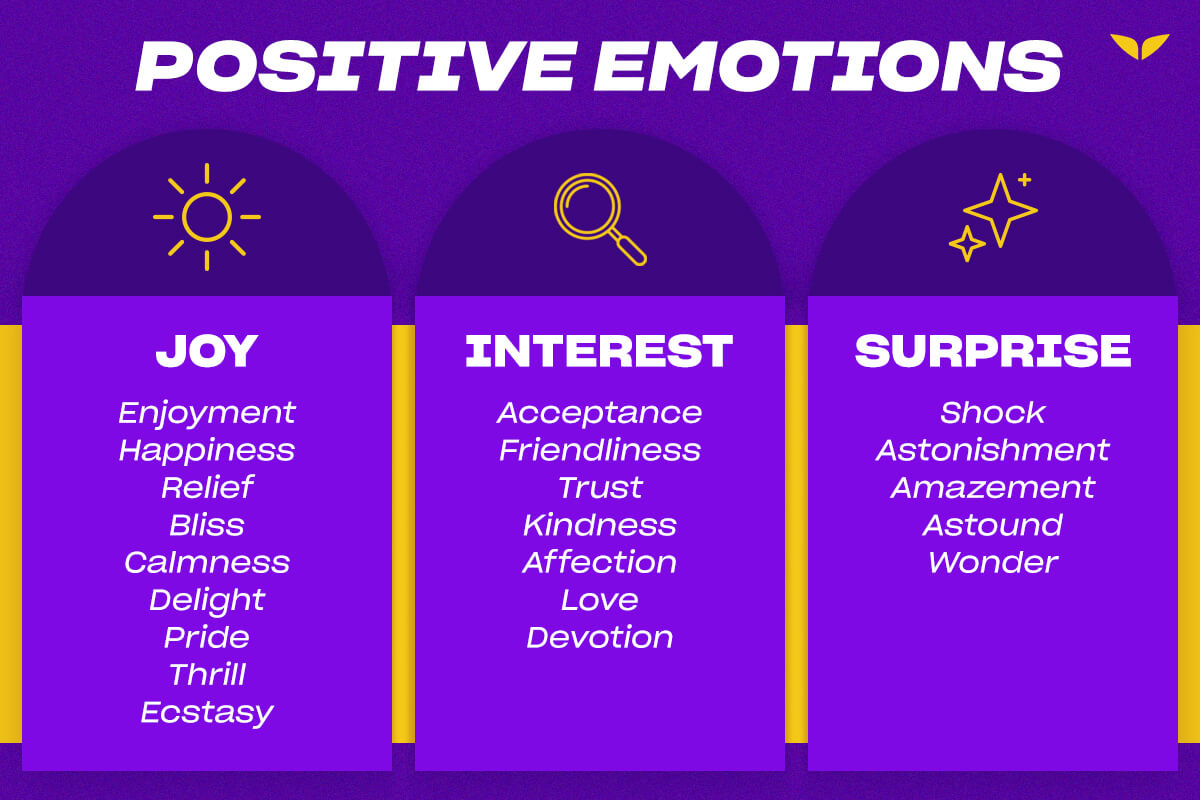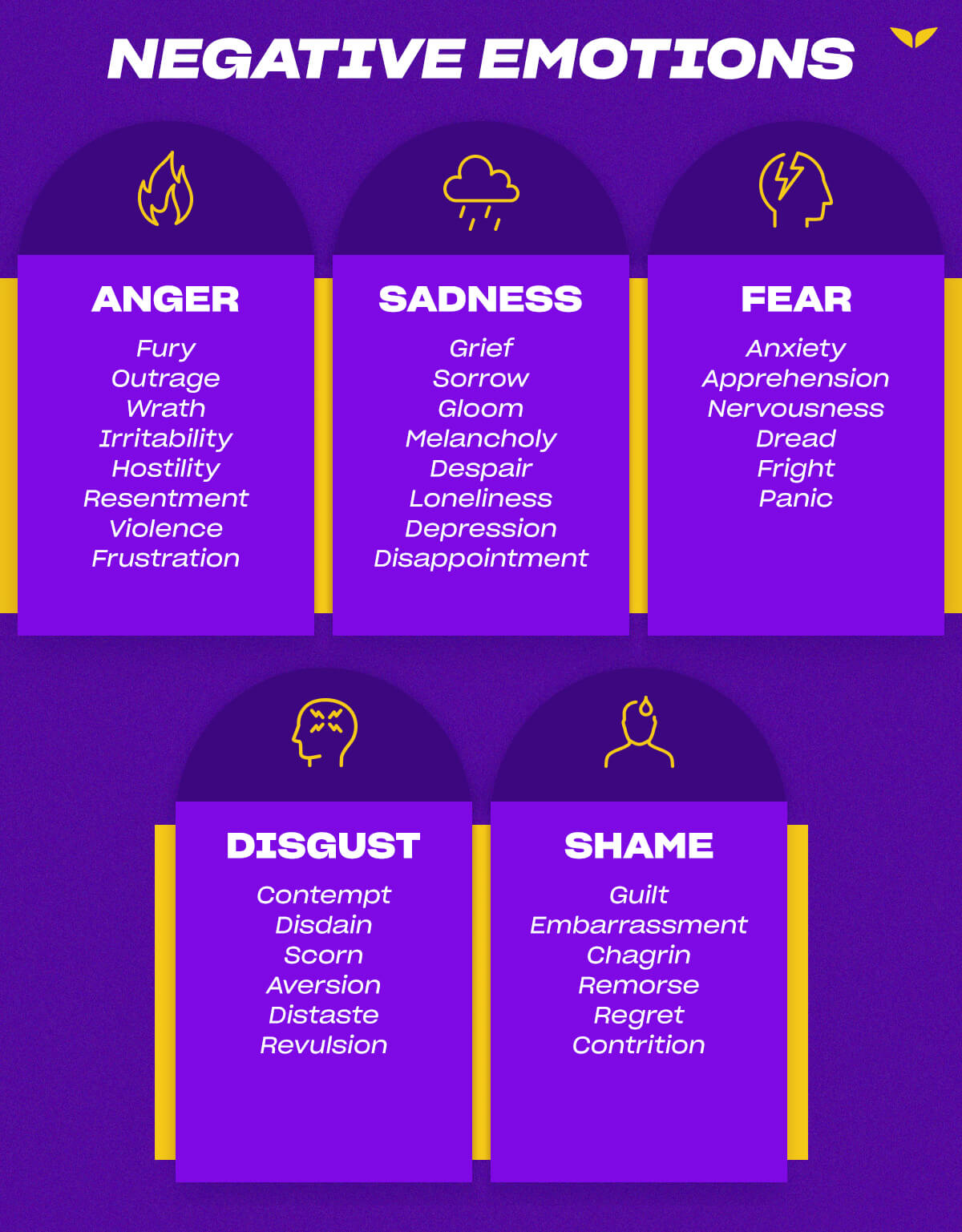Over the years, experts have tried to understand emotions in a number of different ways. What exactly do you feel? How do you feel? And can you understand these processes better?
It can be difficult to express the exact emotion you feel sometimes. Having a comprehensive emotions list can support you in getting to know yourself better. And, of course, coping more effectively with whatever might arise within.
What are emotions?
The most widely accepted definition of emotion is a mental state caused by someone’s circumstances, thoughts, and relationships with others. They are what make you who and what you are.
More often than not, emotions are pretty complex. In fact, it’s not uncommon to feel more than one emotion at a time, which can get confusing—quick.
What are the basic components of emotions?
There are three components of every emotion:
- The physical component. It describes our bodily sensations associated with different emotions. This is the first reaction to an emotional situation, but it can be hard to distinguish different emotions this way. For example, the sensations of excitement are very similar to those of anxiety, which also resembles fear and anger.
- The cognitive (thinking) component. This is arguably the most important part, as our thoughts and emotions are inseparable. Oftentimes, it’s not external circumstances that dictate how we feel but how we look at them. The good news is, we can learn how to control our feelings by changing our thoughts.
- The behavioral component. Finally, many of our emotions call for action. This is what dictates what you do when you feel a strong emotion.
Emotions vs. feelings
Psychology has come to recognize the difference between emotions and feelings.
Emotions are universal to all human beings. They are primal responses to positive or negative triggers, but everyone can experience them at a higher or lower intensity.
On the other hand, your feelings represent the different ways you experience emotions. As part of survival mechanisms, the human system adapted to produce particular emotional and physical responses to different stimuli.
Feelings arise as a reaction to our emotional responses. And they may differ from one person to another.
Types of emotions
Emotions are known to be categorized in various ways. According to different theories and approaches, they can be:
- Primary emotions. These are your body’s first reactions to what’s happened, being very strong and easy to identify. They occur immediately after a significant event and come as an instinctual impulse. As time passes, connecting a primary emotion with an event becomes more challenging, which is when secondary emotions take over.
- Secondary emotions. These are usually harder to understand, as they’re actually reactions to primary emotions. Secondary emotions dictate how we feel about primary emotions. For example, let’s say you get angry at your friend for being late. This is the primary emotion that is connected with the circumstance.
But what would happen if they didn’t show up for an hour? The anger would still be there, but it might be overshadowed by the fear that something might have happened to them.
Even though secondary emotions are harder to understand, they are easier to control because they are not a part of our primal instinct. By examining your thoughts, you can influence your secondary emotions.
Theories of emotions
Some theories suggest that they can be grouped into different categories, according to what it’s causing them:
- Physiological. Physiological theories assume that our emotions are a product of bodily sensations. External stimuli cause our bodies to react, which results in an emotional response.
- Cognitive. These theories seek to explain how our thoughts connect to our emotions and how they are mainly a product of our thoughts.
- Neurological. Neurological theories suggest that all emotions are the result of brain activities.
Additionally, in a more “popular” approach, emotions are labeled to be:
- Positive. These are the different types of emotions that people like feeling and that generate pleasant comforting thoughts and experiences.
- Negative. They refer to those emotions you most often want to escape and run away from.
How many emotions are there?
Throughout history, many competing theories of emotion have emerged. However, studies now have found a list of emotions that accounts for 27 different kinds of feelings. You might not be aware of all of them, but you’ve likely felt them all—in one circumstance or another.
But if you want to distill this emotions list down to its barest essentials, most experts agree that there are only six to eight basic emotions. This theory was first introduced back in the 20th century by Paul Ekman. These are the emotions that blend and morph into more complex ones.
Emotions listed to better understand yourself
EFT (Emotional Freedom Technique) expert Jennifer Partridge, who’s also the trainer of Mindvalley’s Tapping Into Emotional Mastery Quest, believes that “most of the time we haven’t been taught how to deal with emotions, so there is a tendency to numb, avoid, sweep things under the rug and pretend we’re not struggling when we really are.”
Being able to name your emotions is the first step to truly feeling and processing them. It’s an essential part of healthy emotional regulation. Therefore, an emotions list comes in handy when dealing with them effectively.
Primary or basic emotions include the following:
- Anger
- Sadness
- Fear
- Joy
- Interest
- Surprise
- Disgust
- Shame
More complex emotions stem from combinations of the basic ones. Here’s a list of those emotions and feelings:
Positive emotions list
- Joy:
- Enjoyment
- Happiness
- Relief
- Bliss
- Calmness
- Delight
- Pride
- Thrill
- Ecstasy
- Interest:
- Acceptance
- Friendliness
- Trust
- Kindness
- Affection
- Love
- Devotion
- Surprise:
- Shock
- Astonishment
- Amazement
- Astound
- Wonder

Negative emotions list
- Anger:
- Fury
- Outrage
- Wrath
- Irritability
- Hostility
- Resentment
- Violence
- Frustration
- Sadness:
- Grief
- Sorrow
- Gloom
- Melancholy
- Despair
- Loneliness
- Depression
- Disappointment
- Fear:
- Anxiety
- Apprehension
- Nervousness
- Dread
- Fright
- Panic
- Disgust:
- Contempt
- Disdain
- Scorn
- Aversion
- Distaste
- Revulsion
- Shame:
- Guilt
- Embarrassment
- Chagrin
- Remorse
- Regret
- Contrition

Emotion chart
To help people understand them better, psychologists have created a variety of emotion charts and wheels. They’re often used in therapy to help people understand the root emotion behind the more complex ones.
For example, if you’re feeling happy, you also feel peaceful, accepted, or optimistic. Optimism can be a result of hopefulness and inspiration, while acceptance can stem from feeling valued and respected.
If you’ve never used an emotions wheel, you should give it a try. It might help you break down your complex emotions and put things into perspective.
Organs and emotions chart
Emotions are connected to our bodies. Here are the organs and their associated emotions:
- Heart and small intestine: happiness, joy, excitement, hate, impatience
- Spleen, stomach, and pancreas: trust, openness, anxiety, worry
- Lungs, skin, and large intestine: courage, sadness, depression
- Kidney and bladder: calmness, gentleness, fear
- Liver and gallbladder: kindness, anger, frustration
Various biochemical reactions in your internal organs cause your body to react to what you’re feeling. This is why your physical health plays a big role in your emotional responses.
The importance of naming your emotions
You can’t let go of any pain you refuse to feel.
— Jennifer Partridge, trainer of Mindvalley’s Tapping Into Emotional Mastery Quest
Having an emotions list and naming them contributes to emotional regulation and supports your inner mechanisms of processing emotions and feelings. It gives you a space between your triggers and your reactions. And what is more, it lifts up the resistance towards feeling your emotions so that you liberate the energy accumulated within.
In other words, when you name your emotions, you can choose what to do with them from then on.
You can weigh your responses and choose the best one for the situation you’re in. And of course, you can better feel and connect with your emotions when you understand what you’re dealing with.
There is scientific evidence that supports labeling your emotions as well. This 2018 study suggests that turning your feelings and emotions into words will decrease the emotional charge surrounding the experience itself.
Connect to the wisdom within
Discovering more about your inner world includes understanding your emotions better and learning to process them. And this step is essential on your journey of self-discovery.
If you need some help along the way, Mindvalley can come in handy. Your path to connecting to the wisdom of your emotion is possible, and many answers can be found in the Tapping Into Emotional Mastery Quest, guided by EFT expert, Jennifer Partridge.
With her guidance and expertise, you’ll learn how to:
- Listen to your body’s wisdom
- Engage with your emotions
- Move from overwhelmed to overjoyed
- Process uncomfortable emotions
- Celebrate your soul
By unlocking your free access, you can try out sample classes from this program, and many others. What is more, you’ll be part of a like-minded community of people who are as passionate about their emotional mastery journey as you are.
Welcome in.








